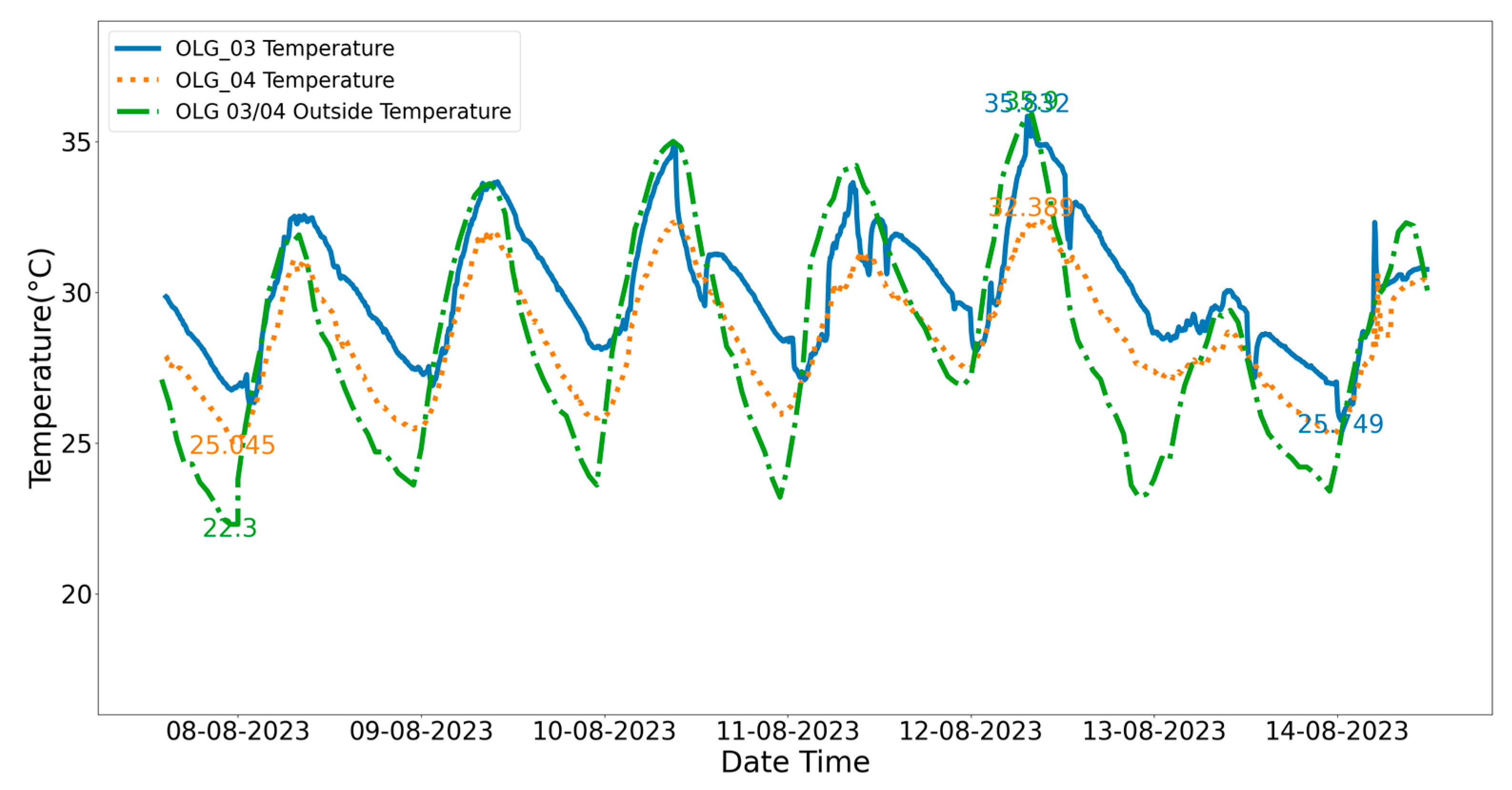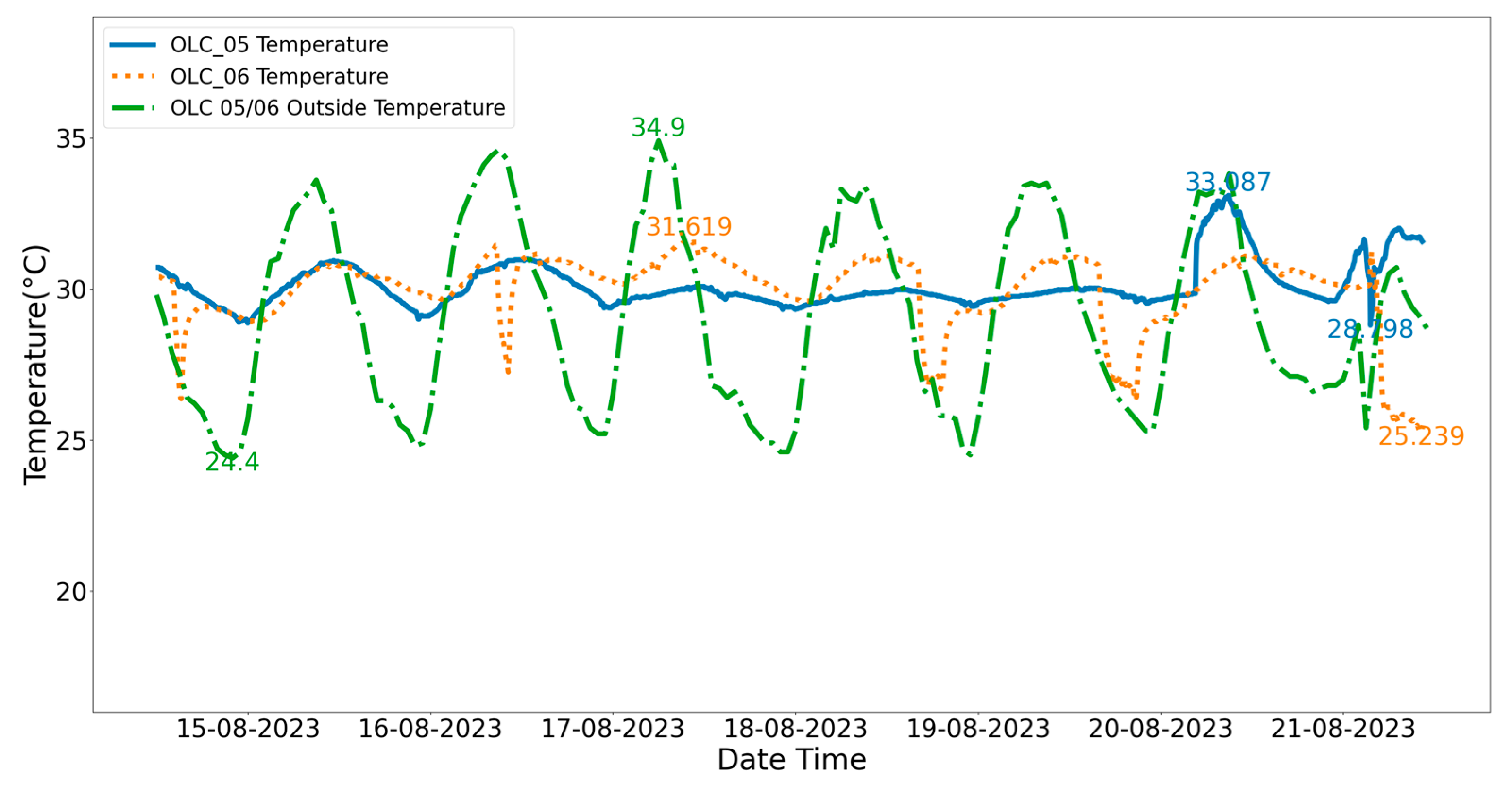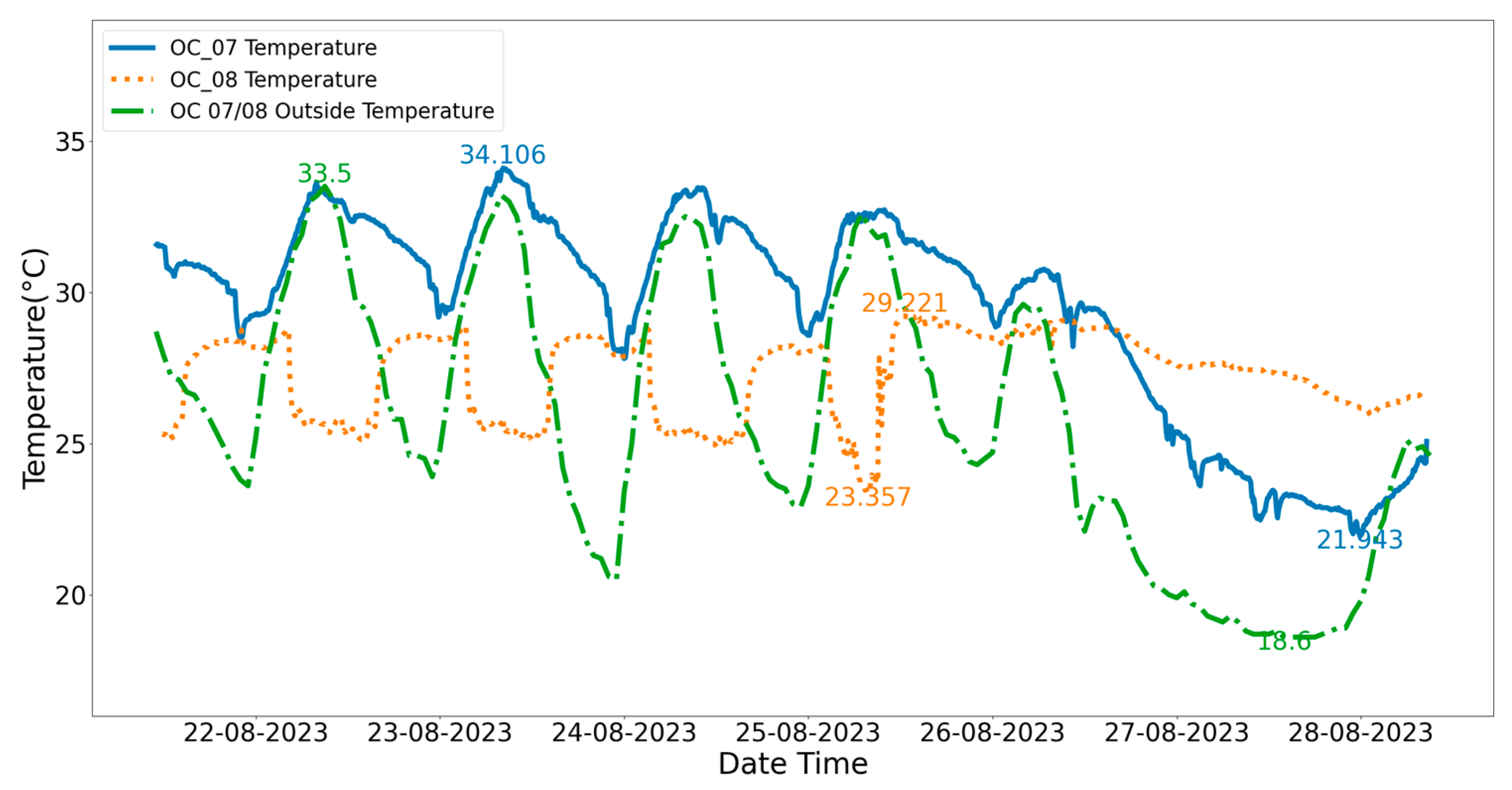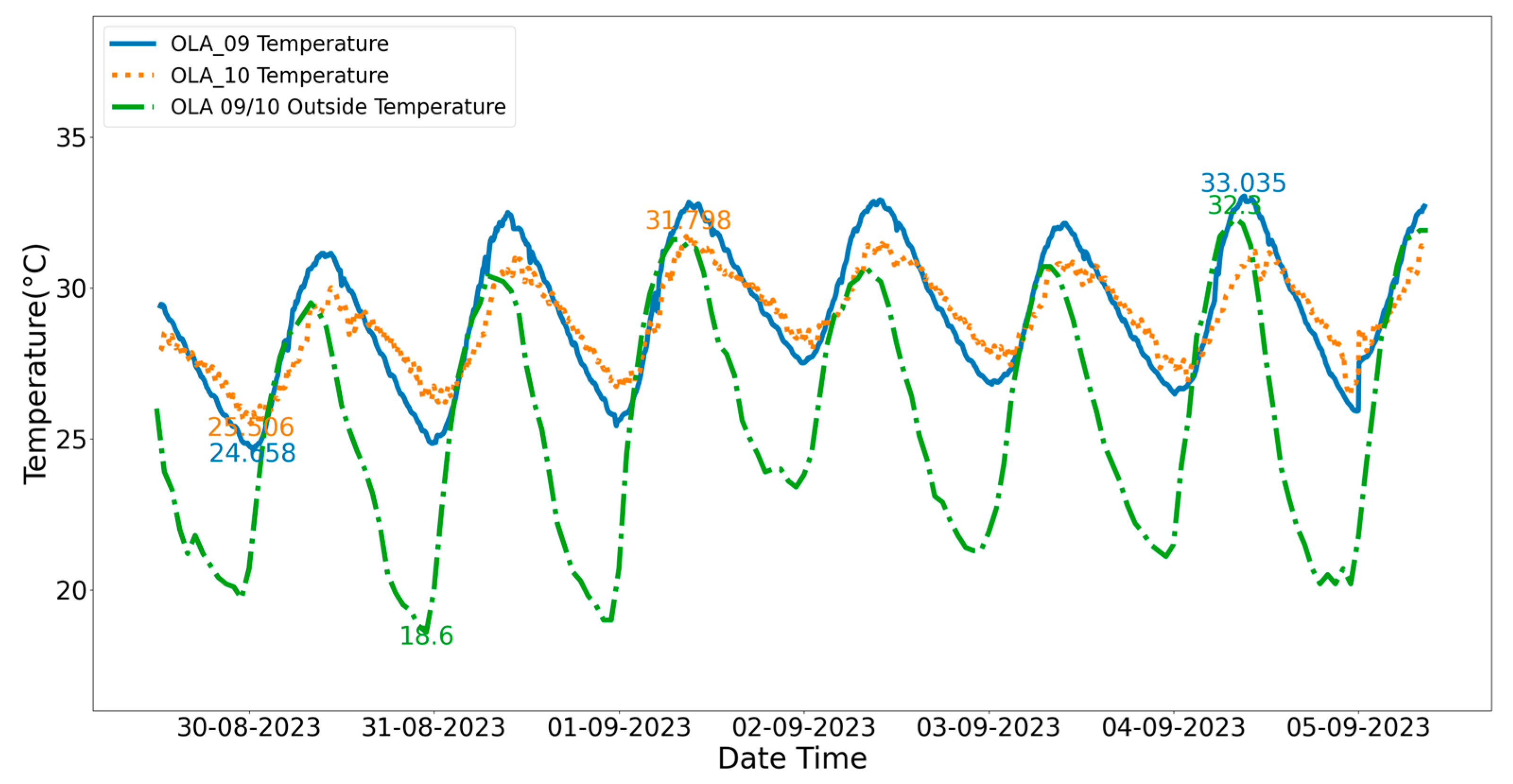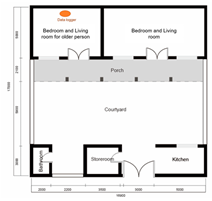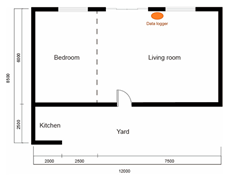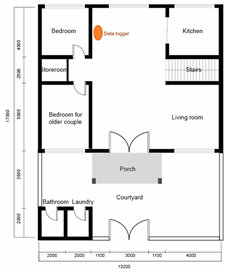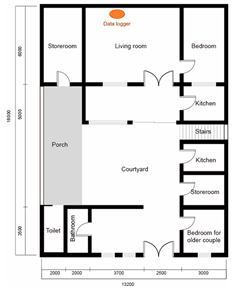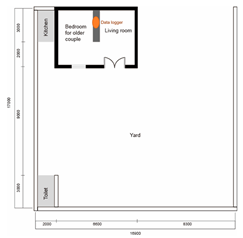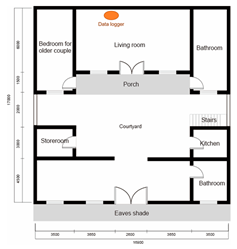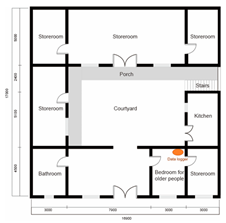3. Results and Discussion
Table 3 delineates the personal characteristics, architectural information, and locations monitored by data loggers for the five types of respondents.
Upon analysing the environmental factors of both residences over a week in summer, as depicted in
Figure 1, the households TGL-01 and TGL-02 with three generations living together exhibited daily temperature and relative humidity patterns that fluctuated in tandem with the external environment. However, the two households showed distinct differences in thermal performance, reflecting how household dynamics, building characteristics, and energy use behaviours influence indoor comfort.
TGL-01 represents an 83-year-old woman’s living space, which serves as a combined living, dining, and sleeping area, separated only by wardrobes. This space exhibited a more stable temperature curve compared to TGL-02, with consistently lower indoor temperatures, averaging 2 °C lower throughout the week. The relative humidity in TGL-01 was higher, likely due to the resident’s daily activities, such as placing water basins in the room and cooking, which contributed to increased humidity levels. The resident’s cooling behaviour was characterized by natural ventilation—doors and windows remained open all day, and she rarely used electric fans, as she described:
“When it’s not too hot, I return to my bedroom to sleep, always keeping the doors and windows open. I also have an electric fan and a cool mat, making for a comfortable living situation.”
The dwelling benefits from a 2 m shaded porch, which reduces solar heat gain, and the architectural insulation is effective. However, no curtains are installed to manage sunlight directly. During times of excessive indoor heat, she relocates to an air-conditioned bedroom for cohabitation with her children. This relocation helps her manage thermal discomfort:
“In recent days, I’ve been spending my daytime in my son and daughter-in-law’s bedroom. Their room is much cooler with the air conditioning on.”
During the interview, the resident emphasized her conservative approach to energy use and reliance on her family for cooler accommodations:
“Ever since my son and daughter-in-law returned from the city to live with me, the air conditioning has been on every day in the summer, costing over 200 yuan in electricity this month. I used to cover the energy costs myself, and even though my son has started to pay the electricity bill, I still cringe every time the fan or air conditioner is turned on.”
In contrast, TGL-02 represents a 60-year-old woman’s living room, which exhibits a longer thermal lag—slower to reach peak indoor temperatures following the peak outdoor temperatures—compared to TGL-01. Despite both households employing a combination of natural ventilation and electric fans, TGL-02 consistently showed more volatile temperature curves and lower relative humidity, with indoor temperatures remaining approximately 2 °C higher than TGL-01.
Several factors contributed to TGL-02’s thermal profile. The 7.5 m by 3 m conservatory in the household reduces direct solar gains but retains more heat. Additionally, the living room experiences greater internal heat gains from family activities and appliance use—the TV, computer, air conditioning, and other electronic devices frequently generate heat, particularly in the evening when the family gathers:
“Around 7 o’clock, our family gathers in the living room for dinner, and my grandchildren spend several hours watching TV in the living room during their summer holidays.”
The larger window area in TGL-02 also results in more solar radiation entering the room, increasing the overall thermal load. The room’s larger space and window size leads to TGL-02 taking longer to cool down after outdoor temperatures drop.
The resident of TGL-02 detailed a more comfortable financial situation, which allows for the use of air conditioning when deemed necessary:
“When I feel hot, I go back to my bedroom and turn on the air conditioning. If it’s not too hot, I just use the fan. Compared to other villagers, my living conditions are better in many aspects.” She acknowledged that her better financial status affords her greater comfort in energy use, and she expressed disbelief at how other villagers manage without such amenities: “I don’t know how others tolerate the heat. I can’t bear it.”
The quantitative data support these qualitative insights, illustrating how energy behaviours, family dynamics, and building design affect thermal comfort. TGL-01 shows lower indoor temperatures and higher humidity, a result of consistent natural ventilation and household activities that introduce moisture. This cooler indoor environment, despite the summer heat, can be attributed to the shading provided by a 2 m porch and the smaller, less complex layout, which minimizes internal heat gains. Additionally, TGL-01 has fewer electrical appliances and less occupancy-related heat, which helps maintain a lower temperature.
In contrast, TGL-02 experiences greater temperature fluctuations and lower humidity due to its larger space, more appliances, and increased internal gains from family activity. TGL-02 takes longer to reach peak indoor temperatures compared to outdoor peaks. This is likely due to the conservatory, which retains heat, and the greater thermal inertia of the larger room size. The internal heat gains in TGL-02 from family members, electronics, and evening gatherings are reflected in the higher and more volatile indoor temperatures. By contrast, TGL-01’s reliance on natural cooling methods and occasional relocation to air-conditioned rooms result in a more stable indoor environment.
These findings underscore how energy behaviours, building features, and socio-economic status shape the thermal environment in rural households. TGL-01’s lower energy consumption reflects the resident’s thrifty energy use approach, while TGL-02’s more active use of electrical appliances and family activities contribute to higher temperatures and internal gains.
Figure 2 presents the environmental conditions within two residences of older couples living with their grandchildren, OLG-03 and OLG-04. Both households exhibited daily temperature patterns that correlated with outdoor temperature fluctuations, with some inherent thermal lag between indoor and outdoor peaks. OLG-03, home to a 65-year-old man and his wife who share their space with their teenage grandchildren, displayed a more volatile temperature curve compared to OLG-04, likely due to the dynamic space usage and the presence of multiple generations within the household. The multifunctional nature of the space—used for living, dining, and sleeping—along with activities such as cooking and door usage, contributed to indoor temperature and humidity fluctuations. The home’s reliance on an open iron door for ventilation and sunlight, combined with the lack of south-facing windows, results in an appropriate level of cross-indoor natural ventilation that reduces the perception of heat.
The interviews reveal how economic conditions influence older people’s choices in forgoing their own thermal comfort to provide for thermal comfort for their grandchildren:
“On exceptionally hot days when we go out to do farm work, the kids turn on the energy-saving air conditioner, which has a lower electricity cost. But if they are at school, we don’t use the air conditioner; just a fan is sufficient for us.”
The resident’s quote highlights a pattern of adjusting energy consumption based on family members’ needs, contributing to more significant internal temperature fluctuations during the day. The descriptive statistical analysis generated from
Figure 2, particularly the blue curve representing OLG-03 from 10 August to 14 August, supports the interview responses regarding energy use behaviour. The fluctuating daytime temperature curve confirms that OLG-03’s temperature is generally higher when the family is active, occasionally even exceeding outdoor temperatures, but shows brief and noticeable drops due to the use of air conditioning.
In addition to the challenges of the need for cooling, the couple faces energy poverty when it comes to cooking, relying on free firewood and straw instead of using a gas stove. Their frugal lifestyle is reflected in the daily temperature profile, which shows a more pronounced increase in indoor temperature during periods of direct sunlight and activity within the home.
OLG-04, monitored in the living room of a 61-year-old woman, reveals a more consistent internal environment with no significant temperature fluctuations, which is supported with the resident’s admission that she frequently uses air conditioning:
“When it’s above 30 °C in the summer, whether during the day or night, I will turn on the air conditioning in the living room or bedroom.”
The stable indoor temperatures suggest that air conditioning is indeed used frequently, as supported by the resident’s lifestyle, despite the fact that she does not pay the energy bills herself. The financial support from her children, who have moved to the city, allows her to use cooling appliances liberally:
“The energy bills are certainly not minor, but all the expenses are paid by my children, and I’m not aware of the exact amount.”
This contrasts sharply with OLG-03, where financial necessity dictates a more frugal use of energy for cooling.
In both households, the presence of grandchildren and the varying levels of financial freedom play a significant role in shaping energy use patterns and indoor environmental conditions. OLG-03 shows greater variability in indoor temperature and humidity, driven by the need to economize on energy and the dynamic use of space by multiple generations. Meanwhile, OLG-04 enjoys a more stable thermal environment, enabled by financial support from the resident’s children, allowing for a more liberal use of air conditioning without concern for the cost.
These narratives illustrate the heterogeneity of energy awareness and financial limitations that shape the living conditions and thermal comfort strategies in rural older households. The temperature profiles in both OLG-03 and OLG-04 provide a clear picture of how household dynamics, socio-economic factors, and energy behaviours influence the thermal environment in rural settings. In OLG-03, the emphasis on energy-saving measures leads to more noticeable fluctuations in indoor temperature, while in OLG-04, financial comfort allows for a more stable and controlled thermal environment.
Figure 3 displays the environmental conditions within two cohabitation residences, OLC-05 and OLC-06, where older individuals reside with children. OLC-05 is the abode of a 62-year-old male and his spouse, who share this newly constructed modern edifice, completed in 2022, with their second son. It is a three-storey building featuring large double-glazed fenestrations without draperies, which account for the observed minimal fluctuations in indoor temperature and humidity, with an interior temperature peak at 33.08 °C. The consistent indoor temperature of OLC-05, as shown in the blue curve in
Figure 3, reflects the building’s efficient thermal performance. This stability can be attributed to several architectural and material choices: the structure is built with load-bearing porous concrete bricks that provide effective insulation, while the doors and windows are constructed from titanium alloy with double-glazed glass, significantly reducing heat transfer. The tiled flooring adds thermal mass, and the large eaves provide shading, helping to block direct sunlight during peak daytime hours. Additionally, the larger room sizes contribute to a more even distribution of heat, reducing sudden temperature spikes. These design elements collectively create a thermally efficient envelope that minimizes heat gains during the day, allowing for a comfortable indoor climate without frequent reliance on active cooling. The stability of the temperature curve further suggests that natural ventilation and the thermal mass of the structure effectively buffer against outdoor temperature fluctuations. This is reinforced by the resident’s comments:
“I find it quite comfortable and have never felt it to be excessively hot. On particularly sweltering days, we use an electric fan in the living room.”
The resident’s perception of comfort aligns with the quantitative data, which show only minor fluctuations in indoor temperature despite the variations in outdoor temperature.
In contrast, OLC-06, a conventional single-storey construction, shows more pronounced temperature variations, as depicted by the orange curve in
Figure 3. The dips in the curve indicate the use of air conditioning to manage indoor heat, especially during the periods of peak outdoor temperatures on 17 and 18 August. The occupant confirmed this reliance on active cooling:
“Summers are certainly hot. We switch on the air conditioner in the living room.”
The quantitative data support this claim, as there are clear drops in temperature corresponding to the activation of the air conditioning unit during the hottest periods of the day. The fluctuations in the OLC-06 temperature curve, compared to the stability of OLC-05, highlight the influence of older construction and less effective insulation on the need for cooling appliances to maintain indoor comfort.
Despite the temperature variations, the resident of OLC-06 does not perceive energy costs as burdensome, noting that while the air conditioning is used frequently, the cost is acceptable. Additionally, the resident occasionally uses a traditional stove, which further reduces their overall energy expenditure for cooking:
“Ordinary life doesn’t make me perceive energy costs as excessive; these are essential energies that must be used. Even though I possess a gas stove, there are times I opt to use the traditional stove to burn firewood and straw for cooking.”
The modern infrastructure of OLC-05, on the other hand, allows the family to maintain comfortable indoor conditions without the frequent use of air conditioning, as evidenced by the consistently low and stable indoor temperatures. The quantitative data reinforce this, showing how the efficient building design of OLC-05 reduces reliance on active cooling, resulting in a more passive approach to temperature regulation. In contrast, OLC-06 requires active cooling measures, such as air conditioning, to mitigate the effects of less efficient insulation and construction materials, which are reflected in the more volatile indoor temperature patterns.
Figure 4 presents the environmental conditions within and outside two residences, OC-07 and OC-08, inhabited by older couples. In this village, older couples living together represent the most common household type, as their children have migrated to cities, leaving the older couples to continue living in the village. Residence OC-07, home to a 75-year-old male and his spouse, is a modest living space of only 33 square meters, the smallest among the interviewees. The space is divided into a bedroom, living, and dining area, partitioned only by wardrobes, and lacks modern sun-shading devices such as curtains or blinds. The metal doors and windows provide minimal insulation, contributing to the consistently higher indoor temperatures seen in the data. Throughout the week, as shown in the temperature chart, the indoor temperatures remained above the outdoor levels, with peaks reaching as high as 34.1 °C, particularly on 24 August. This significant heat retention suggests that the structure of the home, combined with the absence of air conditioning, results in poor thermal performance.
The resident of OC-07, who does not use air conditioning, relies on basic natural ventilation to manage indoor heat, as described in the interview:
“When it gets extremely hot, I turn on the electric fan and strip down to the waist. Although I have a handheld fan, I seldom use it due to laziness.”
This aligns with the quantitative data; even with external temperature dips during the night, the indoor temperature remains relatively high, as the fan alone is insufficient to effectively dissipate heat. The lack of advanced cooling devices and modern insulation in OC-07 leads to persistent discomfort, as evidenced by the resident’s minimalist approach to thermal management.
Furthermore, the economic limitations of OC-07’s residents are reflected in their energy use patterns. With no financial support from their children who have migrated to the city, the couple remains highly aware of their energy expenses, facing energy poverty. Although they own a gas stove, they primarily use a traditional biomass-fuelled stove, burning straw and firewood to cook. This is confirmed in their statement:
“My energy expenditure is quite modest. For cooking gas, I use only three canisters a year, as I predominantly cook with a traditional stove using free straw or firewood. Electricity costs me less than 20 yuan per month, and water is about 130 yuan annually.”
On the other hand, OC-08, home to a 72-year-old woman and her partner, demonstrates a more controlled thermal environment due to the use of air conditioning. The residence is an over-two-decade-old traditional single-storey masonry structure with a sloping roof and a porch. The temperature chart shows a clear pattern of air conditioning use, with the indoor temperature stabilizing during the day when the air conditioner is active. The chart reflects a notable difference between indoor and outdoor temperatures, particularly between 22 August and 26 August, with the air conditioning mitigating heat. After 24 August, a noticeable cessation of air conditioning use is observed, likely due to the significant drop in outdoor temperatures, which reduced the need for cooling appliances.
The resident of OC-08 corroborates this behaviour, explaining how air conditioning provides comfort even during extreme heat:
“When it’s hot outside, I don’t feel the heat once inside, as the air conditioner is on.”
Despite the perception that electricity is costly, the resident prioritizes maintaining a comfortable living environment, emphasizing the importance of air conditioning for thermal comfort, as she explains:
“Air conditioning is only used for about a month in the summer, with this month’s electricity bill around 200 yuan and around 50 yuan in other months.”
While electricity costs are a concern, the residents of OC-08 are willing to bear these expenses for the sake of comfort, in contrast to OC-07, where energy conservation is prioritized due to financial necessity.
The comparison between OC-07 and OC-08 highlights the stark contrast in thermal comfort strategies and energy consumption behaviours. OC-07’s reliance on passive ventilation, combined with minimal insulation, results in consistently high indoor temperatures, whereas OC-08 benefits from active cooling, leading to more stable indoor conditions. The differences in energy consumption behaviour between these households reflect the broader socio-economic disparities and the varying levels of thermal comfort achieved through different energy strategies. This analysis underscores the role of socio-economic factors in shaping thermal comfort in rural older households. While OC-08 can afford to use air conditioning to manage indoor temperatures, OC-07’s limited financial resources and reliance on traditional, low-cost energy solutions like biomass stoves force them to endure higher temperatures and reduced thermal comfort.
Figure 5 illustrates the internal and external environmental conditions of residences OLA-09 and OLA-10, occupied by solitary older individuals, serving as the base case studies for the five distinct types of elderly dwellings examined in this research. Both homes demonstrate diurnal cycles of temperature closely aligned with external environmental patterns, relying extensively on natural ventilation through open doors and windows, combined with the use of electric fans for cooling.
Quantitatively, the temperature curves for both homes show a close correlation with outdoor temperatures, highlighting their reliance on passive ventilation. OLA-09, represented by the blue curve, experiences larger temperature fluctuations throughout the day, with peaks reaching approximately 33 °C on 4 September. These fluctuations are more pronounced than in OLA-10, indicating a greater exposure to external environmental conditions due to the minimal insulation provided by the oiled paper windows rather than glazing. This lack of thermal buffering leaves the indoor temperature vulnerable to rapid increases during mid-day heat, a common issue in structures with insufficient insulation. The resident confirms his approach to managing this heat:
“During summer, there might be a month that’s quite hot, and I generally keep the doors open all day for good air circulation. I have two fans; when guests come over, I’ll turn on the big ceiling fan. For myself, a standing fan is sufficient.”
This practice, while promoting airflow, leads to more significant swings in temperature throughout the day, reflecting the limitations of natural ventilation in providing consistent indoor comfort. The graph highlights how during peak outdoor heat, OLA-09’s indoor temperatures are almost parallel to the external conditions, demonstrating the minimal thermal resistance of the building structure.
The older individual, having lost his spouse, now shoulders the energy bills alone without financial support from children. To economize, he resorts to traditional free stoves, leaving the residence with minimal electrical appliances:
“I rarely cook with gas. Mostly, I cook with a traditional stove burning free straw and firewood from my own fields.”
On the other hand, OLA-10, represented by the orange curve, shows slightly lower temperature peaks and a more stable indoor temperature profile, particularly during the hottest periods. This stability is due to better insulation in OLA-10, resulting in a longer thermal lag—the time it takes for indoor temperatures to respond to changes in outdoor conditions. The lag is evident during the peaks on 4 September, where OLA-10 maintains a more moderate temperature compared to OLA-09, indicating that the building’s insulation slows the heat transfer, preventing rapid indoor temperature spikes. Despite having financial support from her children, which would allow for more energy use, the resident of OLA-10 still refrains from using air conditioning, adhering to habits of frugality:
“At night, if it’s too hot to sleep, I turn on the electric fan, which my son just bought for me this year. All the energy and communication expenses are paid for by my son.”
This decision reflects a deep-rooted approach to energy conservation, despite the availability of modern cooling technologies and financial resources, further emphasizing the balance between thermal comfort and traditional habits of energy savings.
A notable difference between the two homes is the resident’s level of financial independence and their access to resources. OLA-09’s resident, who lives alone with minimal financial support, resorts to basic methods for cooling and cooking, relying on a traditional stove burning free straw and firewood for daily needs. This lifestyle leads to low energy consumption, as evidenced by the greater indoor temperature variability and lack of reliance on energy-intensive appliances. By contrast, OLA-10, though similar in indoor temperature trends, has better insulation and a more comfortable living environment due to the resident’s children’s financial support. Nevertheless, the resident still limits her use of electrical appliances, reflecting cultural norms and a preference for lower energy usage.
The comparison between OLA-09 and OLA-10 reveals how building materials, ventilation strategies, and personal habits influence the indoor thermal environment. OLA-09’s higher temperature peaks highlight the vulnerabilities of buildings with minimal insulation, while OLA-10’s stability illustrates the benefits of passive cooling strategies combined with adequate building insulation. These findings suggest that improvements in building design, such as installing proper insulation or upgrading windows, could significantly enhance thermal comfort for older residents who rely on natural ventilation. Moreover, the residents’ frugal energy practices—whether by necessity or habit—further contribute to the limited use of modern cooling technologies, showcasing how cultural and financial factors intertwine to shape energy consumption behaviours in these rural households.

